#neo heathen
Text
To me the "Witch Tip" to smudge used / old books (Does no one know what smoke does to book binding and paper anymore?!) is as bad as when I saw the "tip" to leave chocolate out as an offering to the nature spirits if you know there are stray dogs around, so the spirits will be incline to protect them. Is someone deliberately trolling occult groups with this stupidity? WHY do people fall for this stuff?!
65 notes
·
View notes
Text
Modest Proposal for Fellow Heathens
Many of you know that I am a neopagan, specifically a Heathen (at least for now), which means that my practice focuses on efforts to revive pre-Christian Nordic-Germanic ways. As part of a slowly burgeoning magico-spiritual practice, I have been learning animism, meaning relating to spirits throughout the natural world and beyond. Because I believe that recovering animism and the best ancient ideals is important to healing a wounded modern world, I intend to write this in such a way as to make sense to people outside the Heathen community. Even still, my main intention is to offer a modest proposal for fellow Heathens. Don’t worry—even though this post’s title is meant to play on Jonathan Swift’s infamous satire, I won’t say anything outrageous.
I think that I should first discuss a certain bit of mythology within Old Norse literature—that will lead directly into my modest proposal soon enough. The mythology tells of the war between the Aesir gods and the Vanir gods. The Aesir have often been associated with civilization while the Vanir have been associated with a sort of tribal life within the natural world. The war ended with a truce and they came together as a family of gods.
One thing that should be kept in mind about this kind of mythology is that it was an oral tradition that developed over time; it was committed to writing concurrently with the process of Christianization. This sort of oral tradition came in the form of sung poetry, and the most impactful and long-lasting poetry makes use of metaphor and subtext. Some scholars dispute that the pre-Christian Norsemen viewed the Vanir and Aesir as distinct groups of gods. On the other hand, that particular tale may reflect encounters between a warrior culture and a pastoral culture somewhere in the distant past. Survival in “wild” places can be quite harsh. The myths involving the Aesir’s rivalry with the Jotun—typically translated as “giants”, and who have been associated with storms and disasters—may reflect the difficulty of building thriving human societies in the face of nature’s harshest aspects. I’d like to note that even some of the giants (such as the frost giantess Skadi, to whom I’ve reached out along with Odin, Freya, and Freyr) are welcomed into the family of the gods—which itself may be read as a parable on welcoming outsiders and even former enemies! It can also be read as a parable on respecting nature instead of trying to conquer it.
Jumping forward to today, hundreds of writers and hundreds of thousands of activists have called out the dire flaws in modern civilization—not because of a supposed lack of authoritarian traditionalism, but because of the most demonstrable harms to the earth and its denizens. Anyone who pays attention to them could conclude that drastic social change and a reconciliation of humanity with the rest of nature are necessary for a sustainable, thriving world civilization. Many people have found Christian institutions wanting, as most notably reflected in many BIPOC individuals attempting to rebuild their earth-based heritages. A small though growing number of European-descended individuals have likewise attempted to revive earth-based heritages under the umbrella of the pagan revival. Heathenry is but one branch.
Heathenry is, sadly, notorious for its entanglement with white nationalism and full-blown Nazism. Within a separate post from a couple of years ago, I offered my thoughts on a book meant to offer a warts-and-all review of the revival of Germanic pagan culture through the modern era. The book discusses Carl Jung’s theory of Odin as an archetype for the “folk soul” of northwestern European peoples and of a need to reconcile and integrate that “folk soul”. Sometimes, you’ll hear of violent racist criminals calling themselves “Odinists” or “Wotanists”. The term “Odinist” was popularized by a Danish migrant to the States who spread an explicitly ethno-nationalist version of Heathenry, while “Wotanist” was popularized by a notorious Neo-Nazi domestic terrorist. People like them have tarnished the reputation of the Germanic pagan revival, particularly in the Anglosphere and, of course, Germany.
There’s certainly nothing wrong with reaching to Odin! As an aspiring magician and healer, I have reached to Odin of the Aesir myself, as Odin is considered a shamanic figure. He most certainly isn’t the simple macho war-god that both wannabe Vikings and Nazi-adjacent gangsters picture him as, but he is still a war-god (and a trickster to boot). The author of the aforementioned book does speculate that a cultural overemphasis on one god, Odin, has inspired ecstatic frenzy—the name Odin can be translated as “lord of ecstasy”—gone wrong. I have also reached out to another shamanic figure, Freya of the Vanir.
Recall that the Vanir are considered fertility deities and are associated with life within the natural world. Recall that more people are seeing a need to reconcile with the natural world. I’ve read books suggesting that Tiwaz or Tyr used to be the chief god of the Germanic tribes before Wodanaz or Odin became the chief god. Folks who take after these old Germanic peoples may consider letting another shift take place as they revive a northwestern European animistic heritage. My modest proposal is that Heathens let Freya and her mythic brother Freyr be the foremost deities.
Freya of the Vanir has many traits in common with Frigg of the Aesir, despite the Eddas depicting them as separate characters, which led to speculation that, at the very least, the Scandinavian cult of Freya developed from the continental cult of Frigg. Freya has been more widely popular within the present-day pagan revival, whether or not admirers and devotees identify as Heathens. Why?
With her ownership of and generosity with her sexuality—befitting a fertility goddess—Freya might easily appeal to women seeking to similarly take charge of their personal lives. Her very name is perhaps more of a title that can be translated as “lady sovereign”, and the status implied by that title might also appeal to a desire for sovereignty under a patriarchal culture. To some extent she is a goddess of battle as well, though mainly in the role of one who chooses a portion of the slain to live their afterlives in her realm.
Let me circle back to Freya as a shamanic figure, one who crosses the veil separating the world of spirits from the human world, bringing back wisdom or magical power. It absolutely should be admitted that “shamanic” and “shamanism” are somewhat slippery terms, as they were first applied to magico-spiritual leaders within certain communities in Siberia before being applied to a wide variety of cultural contexts. Nonetheless, scholars and practitioners alike find them very useful anyway precisely because of striking similarities across cultural contexts. The Old Norse literature depicts Freya as a mistress of a type of shamanism called seidr, which she taught to Odin himself.
Much earlier writing from the Roman historian Cornelius Tacitus gives somewhat meager though still intriguing insight into Germanic tribal culture well before the Viking era started in Scandinavia. Yes, the Germanic tribes had warrior cultures. Tacitus also attested to prophetesses who were given high honor and deference, with commoners and leaders alike looking to those women for guidance. He also claimed that the tribesmen saw women as having a special affinity for such spiritual gifts—which some of todays’ practitioners speak of, even those who reject a strict gender binary or TERF rhetoric. Tacitus has been credited for influencing the later Noble Savage trope! Both the warrior culture and the esteem for prophetesses evidently carried over to early England and Viking-era Scandinavia. The Icelandic poet and politician Snorri Sturluson wrote a saga in which Freya is depicted as a priestess leading rites for the dead king Freyr.
I brought that up because it seemed like a nice way to segue into talking about Freyr (meaning “lord”). Linguistic and literary evidence suggests that Freyr, also known as Ing or Ingvi-Frey, was honored in England as well as Scandinavia. He has been mainly associated with peace, prosperity, and sacral kingship. Within old Germanic societies, kings had priestly duties of providing peace and prosperity to their subjects and the very lands that they held. If you’ll allow me to go on a tangent, Tacitus wrote about Germanic tribesmen engaging in frequent battles which only occasionally ceased. He described one such occasion in some detail, a festival involving a procession of a wagon carrying an idol of the earth-goddess Nerthus. Contemporary Heathens sometimes claim Nerthus as the wife of the Edda-attested Njord, with both as the parents of Freya and Freyr.
It can be surmised, then, that peace was a lofty aspiration among old Germanic societies. One well-known poem within the Eddas depicts Freyr as falling desperately in love with the earth-goddess Gerd. Yes, modern readers may very rightly balk at Freyr allowing his servant to escalate the bribes and eventual threats to get Gerd to be his woman—I actually typed a poetic exercise that touches upon that idea. Some commentators say that it reflects how romantic love can be a trap. Anyhow, when Gerd agrees to be his lover, among the agreements that they make, Freyr willingly gives up his magic sword. Freyr is indeed a warrior who gives up his weapon of war for love. His union with Gerd has been speculated to represent a memory of the very old rite of sacred marriage, in which a ruler would make love with a priestess in the stead of a goddess to hopefully bless the land with plenty. Freyr has been associated with a joyous sensuality as well, potentially offering that as yet another gift.
The Aesir god of truth and justice, Tyr, is more closely associated with the thing—a major public assembly of free men who come together to resolve legal disputes. However, Freyr can also be associated with the thing, a peaceful and partly-democratic method of governance, in defiance of the stereotype of the olden days (albeit a justified stereotype that reactionaries unfortunately glorify). Weapons couldn’t even be carried into the thing. When kings in Scandinavia grew too powerful, migrants to Iceland reinstated the thing and called upon Freyr to guide them.
Heathenry is a relatively small new religious movement with a spotty reputation among the wider public (though, I would hope, nothing like Scientology or Happy Science). I am just one random jackass on the Internet whose following has consistently been very small for over two full decades. However, I do see potential in the animistic pagan revival to do much good for this world as it steadily grows. I’ve attempted to show that Freya and Freyr could potentially make for great figureheads for Heathenry. Freya presents a powerful feminine force offering magic and sovereignty. Freyr offers us a masculine bringer of peace, prosperity, and joy. Both, as members of the Vanir, show us male and female exemplars of living with the natural world. All of us need what they offer very much. Even those who aren’t pagan could look to them for guidance. Surely that is worth a try.
#heathenry#heathenism#norse paganism#paganism#paganblr#pagan witch#freyja#freya#freyr#frey#vanir#germanic paganism#neopaganism#long text#long read#heathens#neo paganism
6 notes
·
View notes
Photo

(via A Few Words About White Supremacists, Nationalists, Neo-Nazis, and Other Fascists)
It’s a sad thing to live in a day and age when this has to be said, but I am vehemently opposed to white nationalism or white pride or whatever you want to call your fascist racism or dress it up as. I’m saying this here and now, loud and clear, because there is a blog making the rounds that purports to be about heathenry but is actually a thinly-disguised white supremacist blog and I’ve noticed that some of you have been liking their posts.
#white supremacists#white nationalists#neo-nazis#fascists#fuck off#heathenry#heathens#antifa#heathens against hate#hate groups#antisemitism#dog whistling#punch nazis#racists#racism#my wordpress#my posts
6 notes
·
View notes
Text
Erinys Sekhmet

#rhodinoverse#fantasy#dark fairytale#lovecraft#scifi#dark fantasy#anime#berserk#wicca#pagan wicca#neo pagan#heathenry#heathenism#triple goddess
2 notes
·
View notes
Text
I have come to really just put down the whole idea of righteousness and being right. Religion is a belief. Religion is for a lot of things. I think the best thing I've done is put aside my own sense of being right about religion. Because there's nothing right or wrong about it. It is what it is, and each person has a varying degree of understanding of what it means to them.
It doesn't matter if someone believes in one god or many gods. We believe what we believe, and it's okay for us to believe it and practice it as long as it doesn't hinder other people's lives. For anyone to attack another based on their belief, it's wrong. It doesn't matter what religion you adhere to.
Obviously, there are complex ideas and things, and I think that's okay. I think it's important for those things to be heard for whatever reason. But especially in trying to convert others to your way of thinking specifically. It's wrong. We can all get along without fighting. Especially in the pagan community. We are so diverse. We need not fight over who is right or wrong. The beauty about paganism is that it isn't consistent. We believe and we practice as we do for our own reasons. Through our own experiences. We don't have laws or rules dictating what is or isn't.
When I speak about this, I mean specifically about neo paganism as a whole but also mostly regarding the revival of ancient religions. What we call reconstructed. People want to imagine it's so specific. Without realizing the vast world there is in that history. The eras, the places, and the people.
In my view, Paganism was never meant to be consistent. It was meant to be personal. It was always based on the needs of those who practiced and lived it. In that way, the spirit of it all lived on. In this way, we do exactly what our ancestors did. Living as we do based on our needs, just as how believing was based on need, not their religious belief.
Idk if any of that makes sense, but it has also allowed me to mingle with others who aren't pagan. Which I think is important to coming together as a whole people, a species, and coming to a compromise about things.
#religion#pagans#heathen#pagan#norse paganism#heathenry#paganism#neo paganism#norse reconstructionism
2 notes
·
View notes
Text
NCT fic recs [Pt. 1]
A collection of mature dark themed nct fics. mostly yandere, mafia or horror (or just messed up themes)
includes all units (nct 127, nct dream, wayv, nct u and former members bc i miss lucas sm)
yuta x reader: Wolf [nakamoto] by @neo-cult-ure
jaehyun x reader: Devoted by @maknaesdancersrappers
mark x reader: Creepin by @killshotbabe
jaemin x reader: PL4YGIRL IS LOVE... by @domjaehyun
doyoung x reader: Invisable by @aehyei
jaehyun x reader: devotion/obsession by @whereisten
yuta x reader: heathens by @yutaholic
sungchan x reader: Infatuation - Sungchan [Pt. 1], [Pt.2] by @stayarmytinyzenmoa-l
taeyong x reader: Late Night Adventures with a Green-Haired Kingpin by @whereisten
mark x reader: zugzwang by @recklessmark
kun x reader: Spoonful Of Sugar;; QK by @kpoptrashlord-007
mainly johnny x reader but some jaehyun x reader: the art of eye contact by @peachydyoung
mark x reader: freakshow by @peachydyoung
lucas x reader: Stranger Danger by @whereisten
#nct smut#yandere nct#nct#nct fanfic#nct yandere#nct fanfic recs#nct recs#nct mafia#nct mafia au#nct yandere au#yuta#mark lee#jaehyun#doyoung#kun#jaemin#taeyong#johnny suh#nct lucas#nct kun#nct taeyong#nct jaehyun#nct mark#nct mark lee#nct johnny#nct johnny suh#nct jaemin#nct doyoung#nct yuta#nct horror
529 notes
·
View notes
Text
Red Flags In Pagan Circles
I've seen a lot of younger, inexperienced members of the pagan (and witchy!) communities fall into some traps set up for them by people who wish to harm them. It saddens my heart to see this happen, as a lot of newer practitioners join these circles so they can learn! And because they're new, they often get taken advantage of.
So I'm creating this non-comprehensive list of some red flags in pagan and witch circles. Again, this isn't comprehensive. I will be updating this as time goes by, so I recommend checking in on this. For each red flag, I'll give a brief explanation as to why it's a red flag. As always, feel free to add your own in the replies and I'll add them to this post!
EDIT: 11/15/2022 - since there's been some people misunderstanding some of the things in this post, I've rewritten a lot of it so hopefully it makes more sense! Apologies to any confusion that's been caused. I also added some of the additions people have reblogged as well!
Usage of the terms "black" and "white" magic:
While this doesn't always mean someone is racist or xenophobic, within occult spaces there's this tendency to use this. The association of darkness/black things being evil isn't always a racist thing (we as humans are naturally afraid of the dark), but it did play a part in the Atlantic slave trade by associating dark skin with animalistic, evil ambitions and light skin as being pure and good. This isn't 100% a red flag, but it's good to keep an eye out when it is used! Another issue is that "black magic" was often used to refer to African traditional magic. It's why you'll often see hoodoo and voodoo portrayed as evil.
Argues that anyone can practice whatever they want, regardless of the status of it being closed or not:
Closed practices are closed for a reason, specifically because these practices have had their people murdered, their land stolen, and their practices made illegal for many years. The reason they are closed is so that outsiders cannot just come into their sacred spaces, take what they want, and bastardize it. The belief that you can join these closed practices without being initiated/born into them is rooted in colonialism and racism. This is one of the biggest red flags.
Some examples of closed practices are hoodoo, ATRs, Native American beliefs, brujeria, and santeria. Some plants are closed as well, so please do your due diligence.
The belief in folkism/volkism: that open pantheons should only be worshiped by those with their blood:
This is the complete opposite of the above. Open pantheons are open because they have not been passed down to us in a single line, and they are currently being revived. As such, these practices can't really be "closed". People who argue that open pantheons should only be worshiped by those with their blood are partaking in the same beliefs as Neo-Nazis. Please watch out for this especially in heathen/Nordic spaces! These people ARE NAZIS.
The specific dogwhistle here is "go back to your roots". (Thank you to @chrisasiaheartman)
Offers to teach advanced practices (baneful magic, deity work, etc.) to newcomers:
It's true that everyone is on different parts of their practice, and not everyone will progress the same way. However, there are certain practices that newcomers should not be doing until they have the basics down. This includes baneful magic and deity work, as you can open yourself up to disastrous consequences if you don't take the proper precautions. This isn't too much of a red flag as often the people doing this do mean well, but it's still something to look out for.
They use the terms "witchcraft" and "Wicca" interchangeably:
They are not interchangeable! Witchcraft is a practice, and Wicca is a religion. These types of people often believe you must be Wiccan to practice witchcraft, which you don't.
They refer to Wicca as an "ancient" religion:
This is false. Wicca was founded in the 1960s. If they do this, it could either be tongue-in-cheek, or it's just blatant misinformation. I would be careful.
They act as though baneful magic is evil.
It isn't. Baneful magic can be a form of protection and self-defense, it is not always a bad thing.
They act as though the "threefold law" is the end-all-be-all of practicing:
Not every witch believes in the threefold law, nor are you required to. This goes back into my point about them believing you must follow Wiccan teachings to practice witchcraft. You don't, period.
The use of racial or cultural slurs, even if they claim it's in a non-discriminatory way:
They are racist. If they're mentioning these slurs in an educational way, that's fine. But if a witchcraft space is just dropping these slurs casually in speech, it's a good sign of them being racist.
They push a specific diet:
You don't need to eat vegan or vegetarian to be a witch. No one has to. Some witches might think that's the best way to practice, and that's fine! Some witches might not subscribe to that idea, and that's fine too!
They push pseudoscience and/or anti-science ideologies (anti-vax, etc.):
This is extremely dangerous. Witchcraft and science can work together just fine. People have done this for so long, and pushing these ideologies can be extremely dangerous to peoples' personal health.
Enforcement of gender binaries:
This is things like the divine "masculine" and divine "feminine". Often times these people will also claim that the womb/uterus should be worshipped as well, and the people who do this are often TERFs/transphobic. Not everyone neatly fits into a gender binary. (Thank you to @hagstone-enthusiast for this!)
They promote the idea that only witches can be female, or that male witches are called warlocks:
Witches can be any gender, and the term warlock is actually derogatory as it means someone broke their oath.
Promotes the idea that mentally ill/neurodivergent witches that that way because they have a strong intuition:
This is very dangerous because being neurodivergent/mentally ill isn't a special thing, and it often is a detriment to many people. People who claim this often believe in indigo children/starseed children. In addition, look out for people to claim that neurodivergent people are that way because they "don't have a position attitude" (thanks to @urchinbeans5000).
2K notes
·
View notes
Text
Is Italian Witchcraft... just Hellenism/Roman Religion?

In the past people asked me why didn't I "just deal with Roman Deities, being Italian".
At first I did not understand how people could not understand that Witchcraft could be a religion, especially Italian Witchcraft, having "new Deities."
The more time passed, however, the more I realized that often the "new Deities" are considered "part" of the pantheon of which they are remnants.
For example, Perchta and Holda are considered part of the Germanic pantheon by many pagans, despite the fact that they are figures who emerged and were present when the Christianization of those peoples had been completed by then.
Similarly, a Hellenist guy recently ranted about the fact that until the early 1800s "saint Demeter" was still worshipped in Eleusis, and he considered this pagan remain in Christian times as part of Hellenism.
Come to think of it, even Leland himself had called his book "Etruscan Roman Remains."
I can understand that Diana and Lucifer might fit in smearily, for example, if Lucifer is understood as an epithet of Apollo (who in fact has Phosphoros as one of his official epithets in the Orphic Hymns themselves)...
But my doubt is, if so, is Madonna Horiente to be considered a Roman goddess?
Is Aradia part of the Roman pantheon?
Are those who worship the Lady of the Game neo-Druids, being in northern Italy, or Hellenists/Religio Romana practitioners, considering that this Deity is now seen as a Roman and now as a Celtic remnant?
Certainly I have a connection with Religio Romana and Hellenism, because of how much of my pantheon I share with them.
From my own personal point of view, I also call myself "Hellenist" (in the sense established by Emperor Julian, thus including the Roman pantheon too).
But as an official classification, regardless of my preferences, I still have doubts about whether Italian Pagan remnants are Hellenism or Religio Romana rather than "Italian Traditional Witchcraft"/"[Region of Italy] Traditional Witchcraft."
It is possible perhaps to divide between:
- Hellenists who also include Greek and/or Italian pagan remnants in the Christian era (or Heathens who also include pagan remnants in the Christian era found in Germanic countries), and
- those who only worship pagan remnants (which I would ONLY call Traditional Witches).
What do you guys think?

#paganism#trad craft#tradcraft#reconstructionist traditional witchcraft#traditional witchcraft#folkloric witchcraft#hellenism#hellenic polytheism#hellenic pagan#religio romana#roman paganism#roman polytheism#stregheria#stregoneria italiana#italian traditional witchcraft#italian witchcraft
24 notes
·
View notes
Note
Hey, what does folkist mean? They are included in your DNI, and I don't think I am one, but I would like to know what to look out for. Urban dictionary doesn't have an entry and ecosia keeps trying to make it folkloreist, and I'm not sure if they are seperate things.
Thank you for your time, and I hope you have a great day/night!
hey, thanks for the question - it's great that you asked!
to put it simply, a folkist is someone in pagan/polytheist spaces that believes only people with the "correct heritage" can practice certain pagan religions even if they are considered to be open
the term folkist has nothing to do with folklore in this context
a common example is heathen folkists believing that only white people can practice heathenry, or that white people have some sort of "special connection" to the Norse Gods because of their DNA
this can also appear in Hellenic polytheism where someone might believe that only people with Greek DNA can worship Greek Gods, etc.
these people tend to appropriate arguments from Indigenous people (which, as a Native pisses me off to no end) and try to apply it to themselves in a gross attempt to try and legitimize their position (which usually just boils down to hating BIPOC and sometimes queer people)
folkists don't typically identify themselves as such, and while they aren't *technically* white supremacists, their beliefs usually line up all too well with white supremacist, fascist or neo-nazi groups
it has a lot to do with just being aware of racism and fascism in pagan spaces which I know is a big/heavy topic that idk if I could fully cover in one post, but I hope this answered your question! 🍇♥
25 notes
·
View notes
Text
Respect Neo-Pagans and Our Gods!
Although they probably will never see it (or care), this post is meant for Hollywood, Netflix, Marvel and all other industries and streaming platforms that are hosting shows based on but twisting pagan or polytheist "mythology" or ancient religions such as Gods of Egypt, Immortals, Clash of the Titans, Thor: Love and Thunder, DT17, Supernatural, Kaos, Twilight of the Gods, Blood of Zeus, Percy Jackson, Xena: Warrior Princess, The Chilling Adventures of Sabrina, Record of Ragnarok, American Gods, The Ritual, The Wicker Man, Lore Olympus, etc.
The trend of creating content that demonizes, humiliates, or insults our Gods is upsetting and unfair. Creative and artistic license is one thing, but it's a double-standard for content about the monotheistic god or religions to be treated with respect even when under academic criticism while are ours are depicted as one-dimensional, villainized and humiliated. We are asking for that same respect.
Yes, content about any kind of "mythology" is fun, but the modern world needs to please remember that these were and still are RELIGIONS to many people around the world, myself included.
People worshipped these Gods, listened to their stories around the fire, married under their vows, raised their children, went to war, and but also built magnificent structures, wrote literature, prayed in their temples, and many more!
In fact, we still have vestiges of their worship! The names of the months and days of the week in the Western world come from Roman or Norse/Germanic Gods, the Olympic Games were originally dedicated to Zeus, the Hippocratic Oath was originally a prayer offered to Apollo, people from all over the ancient world visited the shrine and oracle at Apollo's Delphi, and many more examples.
And while yes, sometimes people were sacrificed to some pagan Gods (not so much the Greeks or Romans), but are we really going to pretend that many more people haven't died in the name of Christianity or Islam??
Lord Zeus wasn't just some womanizer, he was also King of the Gods, Father of Gods and Humans, the God of Hospitality, Oaths, Lightning, Law, Order, Authority, Monarchy, etc.
This was also Lord Zeus of the ancient Greeks:
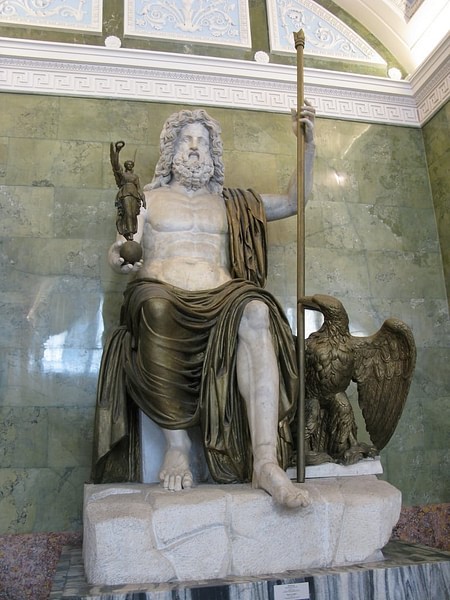
This was also Lord Odin of the ancient Norse:
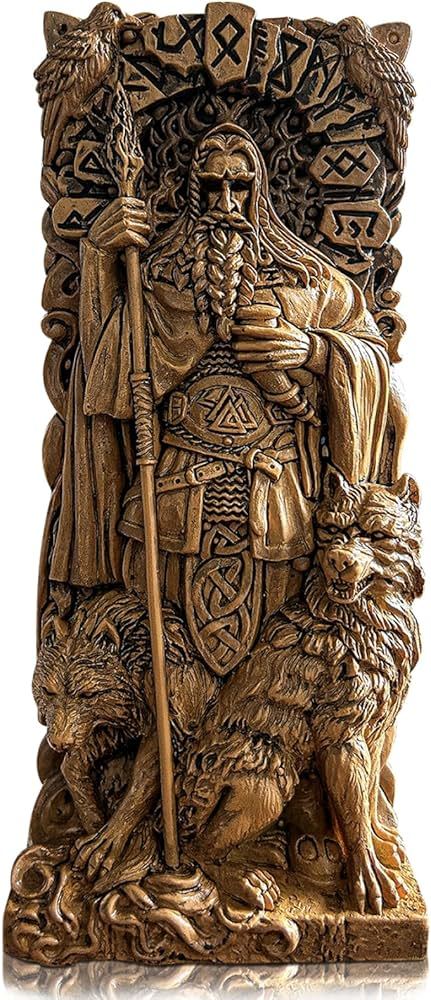
This was also Lady Hera of the ancient Greeks:
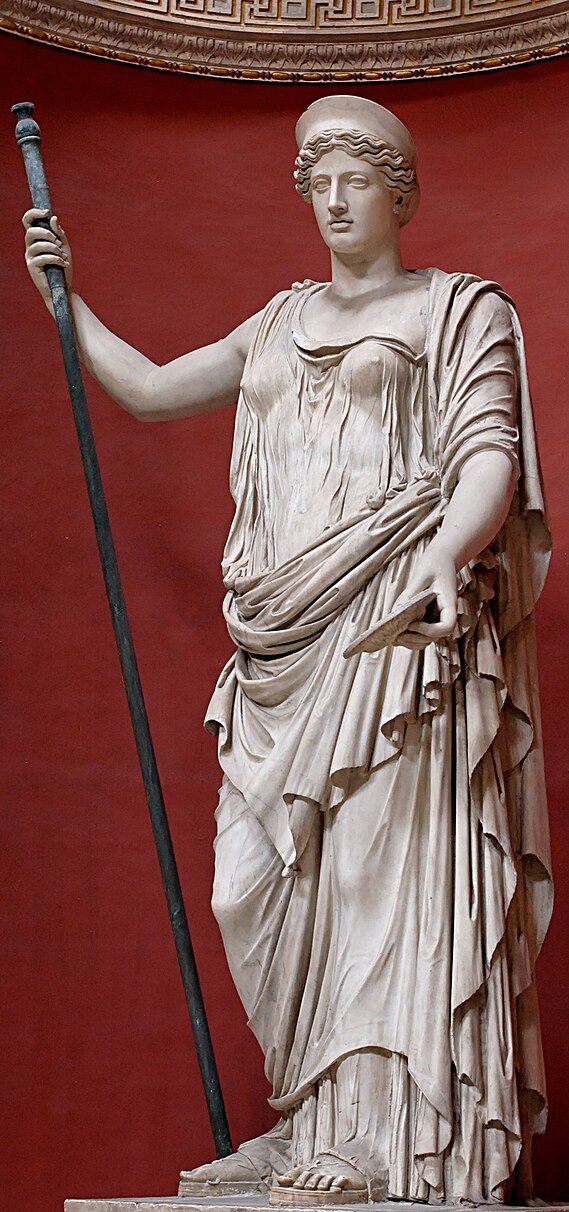
This was also Lord Ra of the ancient Egyptians:

This was also Lord Huracan of the ancient Maya:
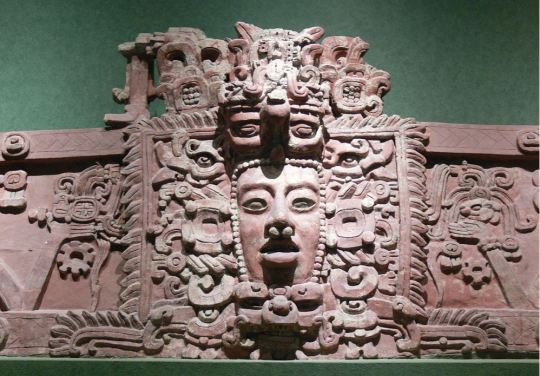
Even if you personally don't worship these Gods, at least respect the fact that your ancestors did. Imagine if 100-200 years from now your descendants start making movies and shows that demonize or humiliate Yahweh, Jesus, Allah and Mohammed, etc.!
In fact, neo-paganism is the fastest growing religion in the United States: https://commonwealthpolicycenter.org/paganism-is-americas-fastest-growing-religion/#:~:text=Paganism%20is%20one%20of%20the,a%20broader%20form%20of%20paganism.
Members of Ásatrù, heathen religion of Iceland, honoring the Norse Gods:

Members of Hellenism, honoring the ancient Greek Gods:
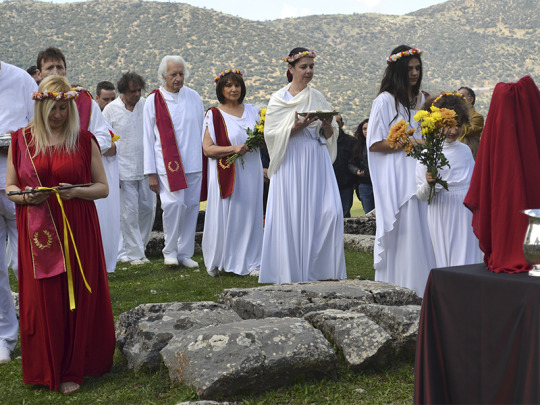
Members of my religion, Nova Roma, honoring the ancient Roman Gods:
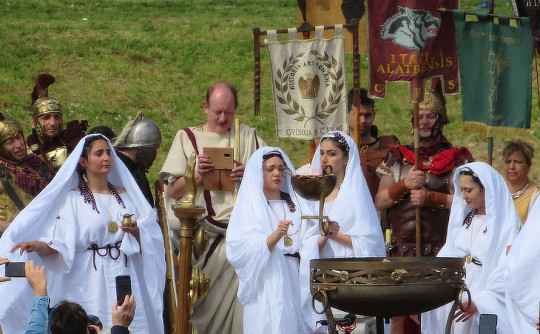
Traditional African religion:

Traditional Maya religion:
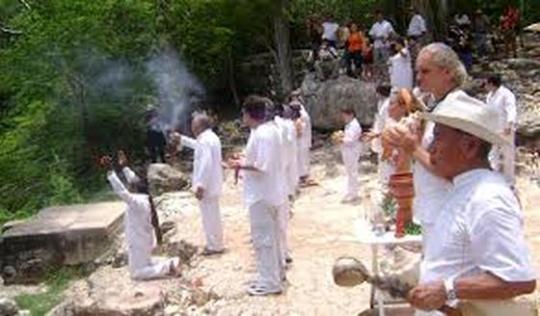
Members of Wicca at Stonehenge, the biggest Neo-Pagan religion in the world with 3-5 million practioners worldwide!

Our Gods are our RELIGION, not just your "mythology!" And both They and we, their followers, deserve the same respect you expect for your religions.
And they at least would never condemn you to an eternal fiery pit simply for not believing in them, unlike some other god I could mention.
They are here. We are here. They exist. We exist. And we are not going anywhere.
#pagan#paganism#mythology and folklore#roman polytheism#hellenic pagan#roman paganism#norse paganism#greek gods#roman gods#wicca#respect all faiths#coexistence#religion#religous themes
16 notes
·
View notes
Text
Resources for Those Wanting to Learn about Pre-Christian Time Reckoning in Northern Europe and its Application in Modern Heathen Traditions
Throughout the history of the modern Neo-Pagan movement, the calendar that has been used by most practitioners has been either the Wiccan Wheel of the Year or another calendar heavily influenced by it. The Wheel of the Year draws largely upon a mixture of Celtic (Gaelic) and Anglo-Saxon traditions, splitting the years into quarters with quarterly and cross-quarterly celebrations and beginning the year at the end of October with the originally Gaelic festival of Samhain.
The calendars that have come to be popular for the majority of the modern Heathenry movement have undoubtedly been based in this calendar, with the major changes being to the names of certain celebrations. On the calendar created by Stephen McNallen for the AFA, Lammas became Freyfaxi, Mabon became Winter Finding, Samhain became Winter Nights, etc. Other organizations such as Forn Sidr of America, The Ásatrú Community, etc. have created their own versions of the calendar as well, but at their roots they all exist essentially as a modification of the Wheel of the Year concept.
More (relatively) recent research and scholarship has brought a greater awareness of older time reckoning systems within Heathen circles as well as amongst history enthusiasts. Some of this has focused on the Old Icelandic calendar as well as the primstav tradition, and while both of these have validity to them the Old Icelandic calendar already had some changes to how it worked from the older system and the primstav used a standardized dating system based in the Julian calendar. Still, these are both useful tools in attempting to reconstruct the pre-Christian (or at least pre-Julian) calendar systems of the Germanic, and particularly Scandinavian, peoples of Northern Europe.
Why is this at all important in an age with the Gregorian calendar used most everywhere and especially for those outside of Scandinavia? Because for those trying the build an understanding of or relationship with these cultures, or even just more connected to the earth in general, the way they reckoned time helps to understand their relationship and connection to their environment, the flow of seasons, how they viewed the different parts of the year and adjusted their activities accordingly, etc. It helps to understand the "why" behind the ritual cycle, even in the names of the months themselves.
Below are a few of the primary resources that I have found helpful in learning about these topics, as well as a graphic representation that I have made based on my research so far to represent the reconstructed Old Norse lunisolar calendar. Note that I don't claim to be an expert on this topic, so I could certainly be wrong in some of the details, and some of the months also have multiple names from which I chose one to use. Also, there were multiple time reckoning systems in use during the period, including a week-counting system, so there can also be conflicting information depending on which is being considered.
Sources:
"Jul, disting och förkyrklig tidräkning: Kalendrar och kalendriska riter i det förkristna Norden" by Andreas Nordberg
- Available as a free PDF, the majority of this is written in Swedish, but it contains a fairly concise English summary at the end. It focuses primarily on Old Norse Jól (Yule) as well as the Dísaþing/Disting and Dísablót in Sweden, but it touches on other celebrations and uses these to establish the overall scheme of the lunisolar calendar system.
"The Festival Year: A Survey of the Annual Festival Cycle and Its Relation to the Heathen Lunisolar Calendar" by Josh Rood
-Also available as a free PDF, this paper expands upon Norberg's work as well as others' and goes through the overall festival year of the pre-Christian Scandinavians.
"The Lunisolar Calendar of the Germanic Peoples: Reconstruction of a bound moon calendar from ancient, medieval and early modern sources" by Andreas Zautner
-This book is sort of a dive into a number of different ancient to early modern calendar systems, but it uses all of these to reconstruct lunisolar time reckoning systems not only for Scandinavians, but for other Germanic peoples as well. It's a great read for those interested in pre-Julian time reckoning in Northern Europe as well as Medieval calendar systems in general.
"The Nordic Animist Year" by Rune Hjarnø Rasmussen
-Similarly to Zautner's book, Rasmussen draws upon a variety of Medieval calendar systems in his work, but his goal, rather than reconstructing an Old Norse calendar is to create a modern calendar based in animist traditions of Northern Europe. It undoubtedly uses the lunisolar system as a base and takes a lot from Old Norse sources, but it also incorporates later traditions which are based in animist knowledge and have value in establishing a system of seasonal animism.
And lastly, my Old Norse lunisolar calendar representation. Each month starts on a new moon, represented by a black dot, and the festivals are shown at the full moons, being white dots. You may notice the lack of Þorrablót and Miðsumar (Midsommar) on here. Regarding Þorrablót, I'm not as well researched on the origins of it and how widespread it may have been. For Miðsumar I have long refrained from including it due to the absolute lack of mentions in literary material from during or shortly after the period, but I have been pointed to some instances of it marked on primstavs as July 14th (Julian calendar), suggesting a possible lunisolar observance of it earlier similar to Jól's relationship to the winter solstice.
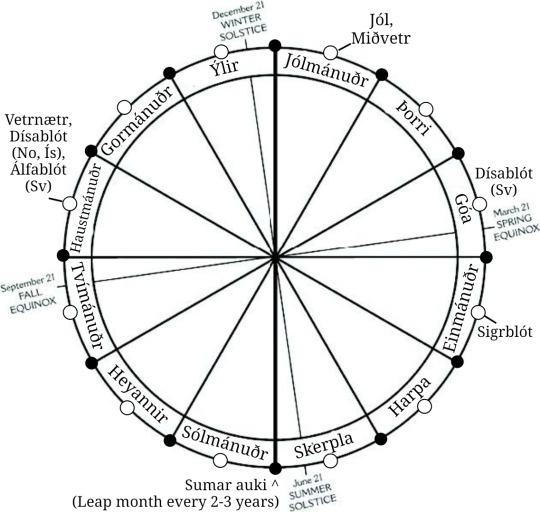
282 notes
·
View notes
Text
Yule is my favorite word for Christmas.
Yule (spelt as Jul in Norwegian, Danish, and Swedish but pronounced as Yule to us English speakers).
I love Yule because it actually entails multiple religions. It may be the result of cultural appropriation but I like to think of it as sharing.
Yule (Jul) is the Norwegian, Danish, and Swedish word for Christmas. It's also the Wiccan Winter Solstice Holiday. It's also the Asatru Winter Holiday. It's also used by many other Neo Pagans.
Yule is so versatile because it means the December Holiday for so many people, from Norwegian, Danish, and Swedish Christians to Wiccan and Asatru.
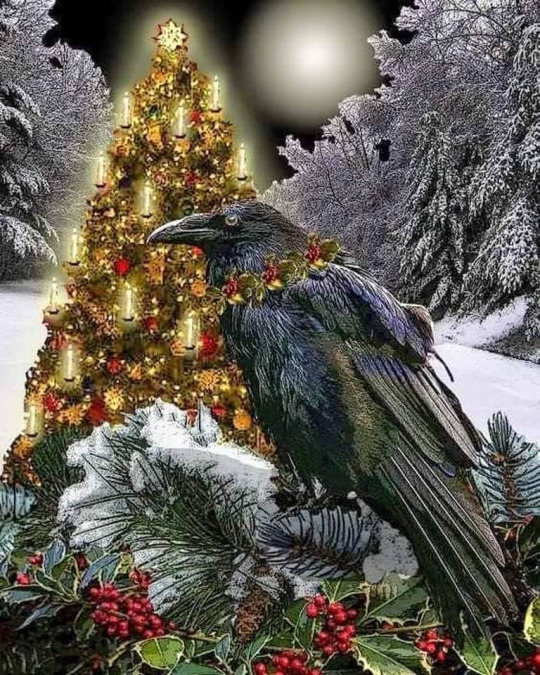
72 notes
·
View notes
Text

I’m glad somebody brought this up because I’ve been meaning to specify a few things concerning this very topic for a while! The reason I tailor my posts to the norse pagan community in particular, aside from the fact that I’m norse pagan myself, is that back when I became interested in heathenry as a spiritual path, there really was no online content tailored to it at all. At least none that I felt was both reliable and inclusive.
I’m fully aware that a lot of what I post applies to most pagan paths! In fact, I write a lot of them while taking into account how a good portion of my followers work with an eclectic set of deities, or simply don’t identify as norse pagan to begin with. This diversity in the neo-pagan social media community is something that I particularly adore.
But something I’ve set my mind on is to provide fellow norse pagans with my own personal experiences, as well as the results of my research on the various topics related to nordic religions and their history. Since I’d noticed that information on the topic of modern norse pagan practices was scarce, I hope to jump in and provide my personal thoughts! Which is why I often enjoy tackling different spiritual topics from a heathen angle, in accordance with my experiences as a heathen.
I hope all feel welcome to take away what they will from my ideas, regardless of their spiritual path!
23 notes
·
View notes
Text
Wicca vs Witchcraft vs Pagan
It's not fair to enter the debate without posting my own definitions, is it? The below just scratches the surface of each of these. I could go on forever and keep in mind - I am a Gemini and will go on forever if given the chance.
Wicca is a form of witchcraft as much as it is a religion. When Gerald Gardner created Wicca his claim was that he was working with an ancient witchcraft tradition. How much of what he had was truly from an old witchcraft tradition is much debated (he borrowed liberally from various sources). Wicca began as an initiatory practice, where a person joined and worked within a specific tradition. On a general level, rituals follow the Wheel of the Year and work with a god and goddess. Practices can vary with tradition and knowledge of practice can vary by degree within a tradition.
Witch is used as a very generic term, often to indicate any magic user. Which is not always correct. My grandmother practiced folk magic but would never have considered herself to be a witch. She was good Southern Baptist. Ceremonial magicians practice magic but don't identify as witches.
So the best way to consider witch is as a form of self-identification. Someone is a witch when they say they are a witch. Generally they would also be practicing some form of magic.
Now Pagan or Neo-Pagan gets a bit more complex. Overall Pagan or Neo-Pagan is sometimes used to mean “A group of people that operates outside societies expectations” with no indication of actual practice. I know the expectation is "pagans worship the old gods" but that isn't always true. Some do. Some, well, see "Party Pagan" below.
Within the Neo-Pagan movement, you'll find Reconstructionist groups who try to recreate, as much as possible, older religions such as Hellenic or Kemetic (ie Greek or Egypt) or Norse or Druidic. But you'll also find people who just consider themselves to be outside of Christianity with no specific structure.
Generally speaking, Wicca and witchcraft traditions may be considered part of the larger Neo-Pagan environment. Perhaps an easy way to see this is that if an area holds a Pagan Pride Day, it may be the best way to meet people from the local initiatory Wiccan covens as well as the local Druids, Heathens and other groups. If an event was labeled “Pagan” it generally just meant everyone was invited.
But the actual practices can be very different. Hellenic and Heathen groups may or may not welcome Wiccans or witches as members. They may practice ritual honoring their gods but want nothing to do with spellwork. Though they may not be as opposed to it as say, the Southern Baptists. Some Neo-Pagans are happy to attend a Wiccan ritual though they wouldn’t hold one themselves. (There is also a term - Party Pagans - which is the crowd that shows up to every ritual or event though no one knows what they actually do on their own.)
Now a word of caution the term Pagan (Neo-Pagan) - this is considered a reclaimed term, meaning we don’t call anyone a Pagan unless they claim that term for themselves. So if you call your Buddhist or Hindu friend a Pagan, they may become upset with you. This is because regardless of any dictionary definition the term Pagan is still used as an insult. The same with Heathen and Witch.
48 notes
·
View notes
Text
This is very important to Heathens to hear, yes, but also for everyone in general.
When it comes to fascists, neo-nazis, white nationalists, and anyone else who subscribes to ideologies punitive to people, FEAR IS THE WISE RESPONSE.
Yes. Fear IS the wise response. Why? Because fear begets caution, which begets attentiveness, and a population that pays attention to their movements is the last thing these kinds of people want.
Remember that fear's biological purpose is to keep us alive, and when it's not inspiring us to run or fight, it's inspiring us to observe and track.
Trying to quash fear under bravery, cockiness, aggressiveness, and/or claims these sorts of people will never have power or influence because they're dumb or whatever, removes your incentive to investigate. And that's how you get eaten by tigers.
95 notes
·
View notes
Text



Callie, Callie, and MORE CALLIE (UPDATED)
❤✨Also here's some Headcanons that explain the art (kinda) ✨❤
Her canon age is around 24-ish? (Correct me if I'm wrong)
-Callie is a bigfin squid so naturally she's a big girl! Like those giant ass squids and also a part of my fear and absolute obsession with the ocean (marine biology/zoology up in this bitch)
-Also took inspiration from a Twitter post(yes I'm a heathen) that Callie checks up on you when you're in alterna like she's your mom! If Marie gets her own agent (Agent 4 the silly) Callie should be able to adopt Neo 3
-Ofc we have to feed the Calf1sh/Dedlie babies so we have a rlly cool drawing (not really cool but I'm trying) that I drew while I was listening to Sweeney Todd's: By The Sea and I'm like "Y'know what? Mrs Lovett's your Callie"
OK OK last one last one Callie is a wee bit taller than Marie because I feel like my favorite idols deserve to be tol
Also Callie is really.. (AND I MEAN REALLY) Strong (I love buff women) It's my personal headcanon that some of the strongest inklings and octos weild rollers
Callie also really likes to spend time with her friends and enjoys shopping and dressing Neo up! She's also really rich as implied in the post-Splatoon 2 hero mode dialogue so she definitely spoils people
Despite her bubbly personality when you mess with someone she really cares about your bitch ass better start running she's a beast
She's very big on touch and is sometimes often really clingy to those deemed safe
Ok that's all my sillies!
#artist#callie splatoon#splatoon 2#splatoon callie#squid sisters#splatoon 3#splatoon#calf1sh#callie x dedf1sh#neoagent3#callie cuttlefish
56 notes
·
View notes